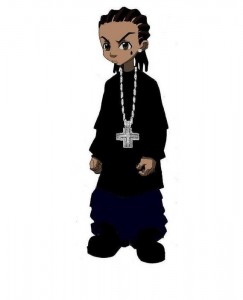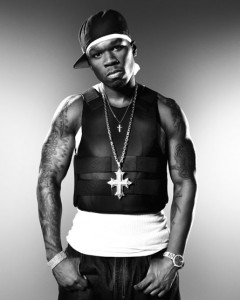While it has become something of a cliché to assert that race poses a significant challenge in the classroom, I have long ceased to think of race and teaching in these terms. Indeed, as a professor of African American literature, I regularly deal with the difficult issue of race and have developed, and help my students develop, tools to grapple with American racial history and persistent racial tensions and conflicts. Which is why I was caught completely off guard in my comics course when I taught Aaron McGruder’s Boondocks and found myself attempting to discuss race with students completely unprepared to do so.
Students in my comics course are primarily white and male, though the ratio of men to women is significantly better than that of white to non-white students. The students are primarily not readers of comics. Out of 45 students, about half of them have read a comic strip or editorial cartoon, but not recently. 7 or 8 of them have read a comic book (usually Maus or Watchmen). Of that 7 or 8, 2 or 3 are currently regular readers of comics, typically superhero comics, or, on occasion, manga. My goal in the course is to introduce students to the many kinds of stories creators tell using this form.
I’ve taught Boondocks before, in Introduction to African American literature. I taught it alongside Toure’s collection of short stories Portable Promised Land. The two works come at the end of my class, and serve as examples of contemporary African American literature informed by (1) the prevalence of blackness in American popular discourse, (2) a long standing and well-established African American literary tradition, and (3) the shifting and competing definitions of blackness in post-Civil Rights America. In that course Boondocks works really well because, I realize now, students have been well prepared for a discussion of how McGruder plays with American racial discourse. Basically, race and blackness are not marginal to the conversation in this course. It’s the very air we breathe.
In my comics course, on the other hand, there is very little discussion of race. In fact, the only time race comes up is when we read books where the race of the characters is explicit (like Boondocks as opposed to something like Stitches or Spider-man) and, thus, unavoidable.
Here is what I want my students to get from The Boondocks: Aaron McGruder employs visual racial hyperbole as the foundation of his satire–we are confronted visually with racial stereotypes (the hood rat, the black militant, the Uncle Tom, the ditzy white girl, the confused biracial girl, etc.) that are then used to simultaneously deconstruct white supremacy and lampoon the absurdity of American racial thinking.
 |
 |
Take the above images, for instance. On the left is Riley Freeman, 8-year old gangsta wanna-be; on the right is rapper 50 Cent. Riley here isn’t simply recognizably black (which he needs to be for the entire premise of The Boondocks to work). He is stereotypically black–the cornrows, the baggy pants, the bling. We are meant to call to mind images from pop culture, like 50 Cent, that present very specific, very limited constructions of black masculinity. Riley is recognizable because we see him everyday. McGruder’s genius, though, is what he does with this stereotype. Riley is a child whose aspirations to thug glory are played for laughs. For instance, to express his outrage at being moved to the suburbs by his grandfather (you can’t have street cred if you come from the suburbs), Riley changes the street sign at the corner from Timid Deer Lane to Notorious B.I.G. Ave. In an early strip, he tried to get a refund on a toy lightsaber because it didn’t do any actual damage when he used to hit Cindy (the strip’s resident white girl) over the head.
The things Riley aspires to–fame as the result of violence, hot and cold running women, conspicuous wealth, swagger that other boys envy–are all things that 50 Cent (and countless other rappers and professional athletes) is famous for. Indeed, they are things that we reward rappers for. In the character of Riley, McGruder not only dismantles this particular stereotype of the black male by showing how much empty performance it is; he also implicates us–the larger culture–in this performance. 50 Cent needs an audience for his gangsta spectacle. And because we–including the students in the comics course–provide him an audience, McGruder’s satire seems to suggest, kids like Riley have every reason to believe the spectacle pays off.
In my African American literature class students, while missing the vocabulary of comics (encapsulation, gutter, panels, etc), are nonetheless able to talk, in basic ways, about the ways McGruder uses the visual language of race. But this is only true because the students and I spend 13 or 14 weeks talking about the various ways race is constructed and becoming comfortable having these conversations. We can have this conversation because it is no different, really, than any of the conversations we have all semester.
In the comics course, though, my students had no context, in general, for McGruder’s racial satire. My comics students don’t recognize the racial markers as markers, as constructions. Instead they read them as authentic: Black men really are that angry and paranoid. Biracial people really are that confused. Black kids really want to be gangsters. Again, it’s not that these kids are incapable of untangling and dismantling social constructions. They are perfectly capable of criticizing constructions of the masculine hero in a superhero comic or recognizing that the childhood represented in Calvin and Hobbes or Peanuts isn’t real, but rather a literary vehicle used to discuss “big ideas.” They had, of course, spent the semester successfully grappling with other kinds of cultural/literary constructions (the “I” in memoirs, journalistic objectivity), but race seemed to exist in a different category from these. It is highly charged, powerful, and invisible to people like my students who benefit from the stereotypes and privilege engendered by racial constructions.
The fact is, most of us are unprepared to talk about race. It is a failure of the culture we live in that the only time my students are having substantive conversations about race is in my 15 week literature class. Despite the fact that, as a society, we talk about race all the time [examples: the racial implications of Strauss-Kahn’s sexual assault of an African maid in his hotel room and Schwarzenegger’s years long affair with his Latina housekeeper; Cornel West’s assertion that the President is scared of free black men; the quickly-pulled Psychology Today article about black women being the least attractive of all human beings; the recent thread on the comics scholars list in which no one, seemingly, knew the definition of womanism], we do it very badly. We are often speaking ahistorically or speaking as if stereotypes are biological and cultural truths or as if color-blindness is the ultimate goal. When my students find themselves in a course where the discussion of race begins with the assertion that none of the above things are true (as my comics students do), but without the proper critical tools, it is not surprising that they fail to rise to the occasion. They are merely replicating failings of the culture they live in.
_________
Conseula Francis is associate professor of English and director of African American studies at the College of Charleston.
